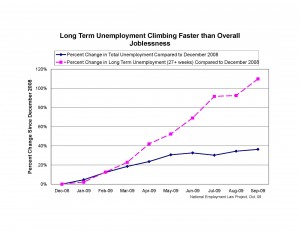09.10.2009
Policy Points
Economic policy reports and media stories of interest:
09.10.2009
Policy Points
Findings from the newest version of the federal Jobs Opening and Labor Turnover Survey …
On the last business day of August, the number of job openings in the U.S. was little changed at a series low level of 2.4 million, the U.S.
Bureau of Labor Statistics reported today. The hires rate was little changed and remained low at 3.1 percent in August. The total
separations rate was little changed and remained low at 3.3 percent
…
The job openings rate was unchanged in August at a rate of 1.8 percent. The number of job openings has fallen by 2.4 million, or 50
percent, since the most recent peak in June 2007. The job openings rate was little changed in August in all industries and regions.
…
The hires level was little changed at 4.0 million in August but has declined by 1.6 million, or 28 percent, since the most recent peak in
July 2006. The hires rate was low in August at 3.1 percent and little changed from July. The hires rate was little changed in August in all
industries.
On the last business day of August, the number of job openings in the U.S. was little changed at a series low level of 2.4 million, the U.S. Bureau of Labor Statistics reported today. The hires rate was little changed and remained low at 3.1 percent in August. The total separations rate was little changed and remained low at 3.3 percent.
…
The job openings rate was unchanged in August at a rate of 1.8 percent. The number of job openings has fallen by 2.4 million, or 50 percent, since the most recent peak in June 2007. The job openings rate was little changed in August in all industries and regions.
…
The hires level was little changed at 4.0 million in August but has declined by 1.6 million, or 28 percent, since the most recent peak in July 2006. The hires rate was low in August at 3.1 percent and little changed from July. The hires rate was little changed in August in all industries.
08.10.2009
Policy Points
Economic policy reports and media stories of interest:
08.10.2009
Policy Points
A new report from The Bookings Institution analyzes the state of air travel in the United States and flags the challenges that will need to be addressed when economic growth returns. Specifically, the report argues that that too much of the nation’s commercial air system is focused on heavily trafficked, inefficient short corridors connecting a handful of metro areas.
Key findings include the following:
- Some 99% of all airline passengers (annualized share) travel between or through one of the nation’s 100 largest metro areas. And 61% of all passengers are heading ultimately to one of the nation’s 25-largest metros.
- Half of all airline flights operate on routes of 500 miles or less with the busiest routes operating between a handful of metro areas (e.g. Los Angeles-San Francisco; New York-Washington, DC).
- The nation’s 26 largest metro areas (especially New York) are responsible of an increasing share of all airline delays.
read more


 Email Sign-Up
Email Sign-Up RSS Feed
RSS Feed